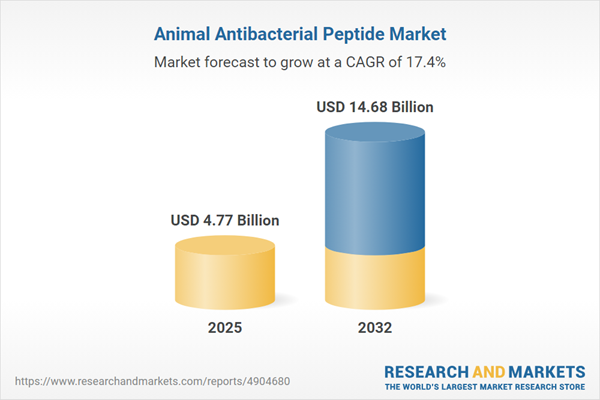Speak directly to the analyst to clarify any post sales queries you may have.
The animal antibacterial peptide market is evolving rapidly as industry and research leaders seek innovative solutions to pressing livestock health challenges. As regulatory expectations and resistance concerns intensify across animal agriculture, leading organizations are pivoting toward next-generation peptide therapeutics that promise efficacy, adaptability, and commercial scalability.
Market Snapshot: Animal Antibacterial Peptide Market Growth and Trends
The Animal Antibacterial Peptide Market grew from USD 4.06 billion in 2024 to USD 4.77 billion in 2025. It is expected to continue growing at a CAGR of 17.40%, reaching USD 14.68 billion by 2032. Breakthroughs in peptide design, manufacturing, and regulatory alignment are fueling this momentum, redefining disease management standards in livestock and aquaculture. Strategic collaboration and localized production are shaping supply chain security amidst market complexities.
Scope & Segmentation: Comprehensive Coverage of Critical Market Dimensions
This report provides in-depth coverage and analysis across all key dimensions of the animal antibacterial peptide industry, enabling a precise understanding of commercial opportunities and operational risks.
- Product Typology: Naturally derived peptides, Synthetic peptides (long chain, medium chain, short chain).
- Application Areas: Growth promotion, Prophylactic including disease prevention and vaccination adjuvant, Therapeutic including infection treatment and skin disease treatment.
- End Users: Aquaculture farms, Feed manufacturers (aquafeed, livestock feed), Research institutes (academic, biotech firms), Veterinary clinics (large animal, small animal practices).
- Regional Coverage: Americas (North America, Latin America), Europe, Middle East & Africa (Europe, Middle East, Africa), Asia-Pacific.
- Technological Use: Genomic and proteomic tools, custom peptide synthesis, scalable manufacturing platforms, supply chain digitization, AI-driven design, advanced delivery and formulation systems.
- Representative Companies: Zoetis Inc., Elanco Animal Health Incorporated, Merck & Co., Inc., Boehringer Ingelheim International GmbH, Esco Aster Pte. Ltd., Biosynth Ltd, Vetoquinol S.A., Phibro Animal Health Corporation, Dechra Pharmaceuticals PLC, Neogen Corporation.
Key Takeaways for Decision-Makers
- Significant scientific progress and customized peptide development are offering multifaceted alternatives to traditional antibiotics, minimizing resistance and enabling sustained productivity improvements.
- Strategic partnerships between biotech innovators, academic institutions, and established animal health companies are catalyzing new product pipelines and accelerating commercialization across core livestock and aquaculture segments.
- Regional trends reveal that rapid growth in Asia-Pacific is driven by increased aquaculture investments and stringent consumer safety demands, while North America and Europe benefit from research investments and regulatory innovation.
- End user diversity, ranging from aquaculture to veterinary clinics, underscores the necessity for tailored product formulations and targeted go-to-market strategies across the animal health value chain.
- Industry leaders are focusing on advanced manufacturing, AI-enabled screening, and continuous process improvement to optimize cost efficiency and large-scale deployment of antibacterial peptides.
- As policymakers prioritize antimicrobial stewardship, progressive regulatory pathways and policy support are accelerating market adoption in several regions.
Tariff Impact: Navigating Trade and Supply Chain Realities
The 2025 United States tariff measures on peptide imports have reshaped supply chain strategies and investment flows. Companies are shifting sourcing to domestic and regional facilities, which is prompting infrastructure upgrades amid transitional supply fluctuations. Collaborative alliances and integrated sourcing networks are helping mitigate risk and maintain market accessibility during ongoing trade adjustments.
Methodology & Data Sources
This report integrates primary research—interviews with veterinarians, aquaculture experts, and industry executives—with comprehensive secondary analysis of scientific literature, patents, and regulatory documents. Supply chain mapping and cost-performance synthesis further inform the competitive landscape. Data triangulation guarantees consistent, reliable insights and actionable intelligence.
Why This Report Matters for Senior Leaders
- Gain clarity on competitive dynamics, emerging technologies, and segmentation trends to inform strategic planning and commercial investments in the animal antibacterial peptide market.
- Leverage detailed analysis of tariff impacts, regulatory frameworks, and regional growth drivers to optimize supply chain decisions and go-to-market execution across diverse animal health end users.
- Equip decision-makers with a robust foundation for risk management, product differentiation, and proactive engagement with evolving policy standards worldwide.
Conclusion
The animal antibacterial peptide landscape is defined by swift scientific progress, shifting trade policies, and expanding commercial opportunities. Leaders who align innovation, operational agility, and strategic collaboration will shape sustainable growth in animal disease management.
Additional Product Information:
- Purchase of this report includes 1 year online access with quarterly updates.
- This report can be updated on request. Please contact our Customer Experience team using the Ask a Question widget on our website.
Table of Contents
3. Executive Summary
4. Market Overview
7. Cumulative Impact of Artificial Intelligence 2025
Companies Mentioned
The companies profiled in this Animal Antibacterial Peptide market report include:- Zoetis Inc.
- Elanco Animal Health Incorporated
- Merck & Co., Inc.
- Boehringer Ingelheim International GmbH
- Esco Aster Pte. Ltd.
- Biosynth Ltd
- Vetoquinol S.A.
- Phibro Animal Health Corporation
- Dechra Pharmaceuticals PLC
- Neogen Corporation
Table Information
| Report Attribute | Details |
|---|---|
| No. of Pages | 195 |
| Published | October 2025 |
| Forecast Period | 2025 - 2032 |
| Estimated Market Value ( USD | $ 4.77 Billion |
| Forecasted Market Value ( USD | $ 14.68 Billion |
| Compound Annual Growth Rate | 17.4% |
| Regions Covered | Global |
| No. of Companies Mentioned | 11 |









